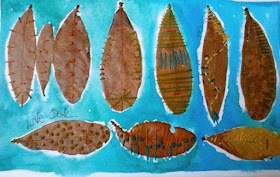Have you ever used the actual plant in your artwork? Although
dried plants may not be archival into the next century, there are times
when I have used them as records, souvenirs, and art objects.
Years ago, I used my plant press to dry
and store ferns, flowers, and leaves for my framed plant and paper collages
that I sold at art fairs and from my studio. I see them occasionally in friends’
homes and I kept a few for myself, so I have kept track of their aging
processes. The news is good – all have fared well, usually changing over time from their fresh
green colors to rich golds and browns. I always posted information on the
backs of the framed pieces to the effect that the dried plant material could be
expected to transform beautifully.
 |
| Fern collage 12+ years after framing |
One winter while staying in Florida with my mom, I was participating in an online daily creative practice. Each day when I walked in local parks or on the beach, I collected leaves, small plants, and feathers that I embroidered onto my sketchbook pages. I identified each species and painted the backgrounds with watercolor. The 8 or so pages made a nice group that I framed informally together.










Very interesting Chris. Thank you for sharing.
ReplyDeletethanks for that lovely post. Yesterday i weeded out some ferns and have the intention of using the as a mask for larger fabric i paint. Decades ago i made my own flower and leaf press from an old phone books preserving lots of ferns, interesting leaves and bougainvillea bracs kept color for a while: oleanders in red where the best.
ReplyDeleteSo lovely. I have one of your framed ferns. I am delighted to read this. Colleen
ReplyDeleteAs a quilting botanist myself it's been a fascinating read, thank you !
ReplyDeleteA botany book I'd recommend is the Kew Plant Glossary: http://shop.kew.org/the-kew-plant-glossary-an-illustrated-dictionary-of-plant-identification-terms-second-edition-2016.
Even my non-plant friends have been fascinated by the pattern potential in the illustrations ( eg leaf shapes, margins, diagrams of types of plant hairs)
So many nice comments! We're a tribe, I think. And thanks for reference to the Kews publication. I'll check it out. Love to all.
ReplyDelete